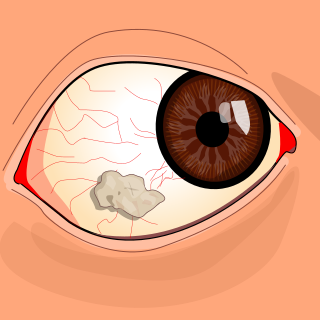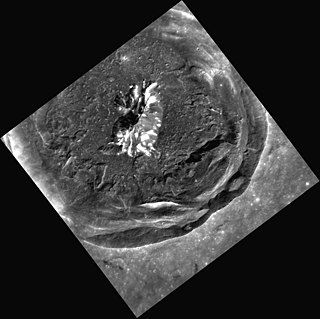Related Research Articles

Jupiter is the fifth planet from the Sun and the largest in the Solar System. It is a gas giant with a mass more than 2.5 times that of all the other planets in the Solar System combined and slightly less than one-thousandth the mass of the Sun. Its diameter is eleven times that of Earth, and a tenth that of the Sun. Jupiter orbits the Sun at a distance of 5.20 AU (778.5 Gm), with an orbital period of 11.86 years. It is the third brightest natural object in the Earth's night sky, after the Moon and Venus, and has been observed since prehistoric times. Its name derives from that of Jupiter, the chief deity of ancient Roman religion.

The leopard is one of the five extant species in the genus Panthera. It has a pale yellowish to dark golden fur with dark spots grouped in rosettes. Its body is slender and muscular reaching a length of 92–183 cm (36–72 in) with a 66–102 cm (26–40 in) long tail and a shoulder height of 60–70 cm (24–28 in). Males typically weigh 30.9–72 kg (68–159 lb), and females 20.5–43 kg (45–95 lb).

The G-spot, also called the Gräfenberg spot, is characterized as an erogenous area of the vagina that, when stimulated, may lead to strong sexual arousal, powerful orgasms and potential female ejaculation. It is typically reported to be located 5–8 cm (2–3 in) up the front (anterior) vaginal wall between the vaginal opening and the urethra and is a sensitive area that may be part of the female prostate.
In finance, a forward contract, or simply a forward, is a non-standardized contract between two parties to buy or sell an asset at a specified future time at a price agreed on in the contract, making it a type of derivative instrument. The party agreeing to buy the underlying asset in the future assumes a long position, and the party agreeing to sell the asset in the future assumes a short position. The price agreed upon is called the delivery price, which is equal to the forward price at the time the contract is entered into.

A Sun-synchronous orbit (SSO), also called a heliosynchronous orbit, is a nearly polar orbit around a planet, in which the satellite passes over any given point of the planet's surface at the same local mean solar time. More technically, it is an orbit arranged so that it precesses through one complete revolution each year, so it always maintains the same relationship with the Sun.

Bitot's spots are the buildup of keratin located superficially in the conjunctiva of human's eyes. They can be oval, triangular or irregular in shape. The spots are a sign of vitamin A deficiency and associated with drying of the cornea. In 1863, the French physician Pierre Bitot (1822–1888) first described these spots. The spots may abate under replacement therapy. In ancient Egypt, this was treated with animal liver, which is where vitamin A is stored.

Ceres is a dwarf planet in the middle main asteroid belt between the orbits of Mars and Jupiter. It was the first known asteroid, discovered on 1 January 1801 by Giuseppe Piazzi at Palermo Astronomical Observatory in Sicily, and announced as a new planet. Ceres was later classified as an asteroid and then a dwarf planet, the only one not beyond Neptune's orbit.
The spot market or cash market is a public financial market in which financial instruments or commodities are traded for immediate delivery. It contrasts with a futures market, in which delivery is due at a later date. In a spot market, settlement normally happens in T+2 working days, i.e., delivery of cash and commodity must be done after two working days of the trade date. A spot market can be through an exchange or over-the-counter (OTC). Spot markets can operate wherever the infrastructure exists to conduct the transaction.

Japan participated in the 1998 Asian Games held in Bangkok, Thailand from December 6, 1998 to December 20, 1998. This country was ranked 3rd with 52 gold medals, 61 silver medals and 68 bronze medals with a total of 181 medals to secure its third spot in the medal tally.
The Kazakhstan men's national tennis team represents Kazakhstan in Davis Cup tennis competition and are governed by the Kazakhstan Tennis Federation. In 2011, Kazakhstan competed in the World Group for the first time after they won against Switzerland in the 2010 World Group play-offs. After the first round win against the Czech Republic in 2011, Kazakhstan secured their spot in the World Group for the 2012 Davis Cup. They lost in the first round to Spain, but defeated Uzbekistan in the play-offs, which again kept them in the World Group for 2013. In 2013, they defeated Austria in the first round, but lost to the Czech Republic in the quarterfinals.

Blyth's frogmouth is a species of bird in the family Podargidae. It was previously considered to be conspecific with the Javan frogmouth and Palawan frogmouth. The bird is a tropical species that ranges from India to Australia.

Vivaldi is a crater on Mercury. It was named by the IAU after Italian composer Antonio Vivaldi in 1976. It has a prominent and nearly continuous inner ring whose diameter measures about half that of the outer ring. It is one of 110 peak ring basins on Mercury. Unlike some of the lunar multiringed structures, no vestiges of additional rings are apparent around this crater. It is classified as c3 age.

Matisse is an impact crater on the southern hemisphere of Mercury. Matisse takes its name from the French artist Henri Matisse, and it was named by the IAU in 1976.

Xiao Zhao crater is small in comparison with many other craters on Mercury. However, Xiao Zhao's long bright rays make it a readily visible feature. The fresh, bright rays, which were created by material ejected outward during the impact event that formed the crater, indicate that Xiao Zhao is a relatively young crater on Mercury's surface.

Cunningham is a young crater on the western floor of the Caloris Basin, on Mercury. It is surrounded by a bright ray system.

Sander is a crater on Mercury within Caloris Basin. It has dark walls and bright patches on its floor. Unlike the rays of Bashō crater, the bright areas are not believed to be immature, but they are inherently bright. It is named after the German photographer August Sander (1876–1964).

Nāwahī is a crater on Mercury. Nāwahī crater is located within the large Caloris basin, near the western rim. The unusual dark material creating a halo around Nāwahī makes this crater of special interest, as the dark material likely represents rocks with a different chemical and mineralogical composition than those of the neighboring surface. The crater is named after Hawaiian patriot and painter Joseph Nāwahī.
Halasal is a village in Belgaum district in the southern state of Karnataka.

Bartók is a crater on Mercury. Its name was adopted by the International Astronomical Union (IAU) in 1979. Bartók is named for the Hungarian composer Béla Bartók, who lived from 1881 to 1945.

Kipling is a crater on Mercury. It has a diameter of 164 kilometers. Its name was adopted by the International Astronomical Union (IAU) in 2010. Kipling is named for the British author Rudyard Kipling, who lived from 1865 to 1936.